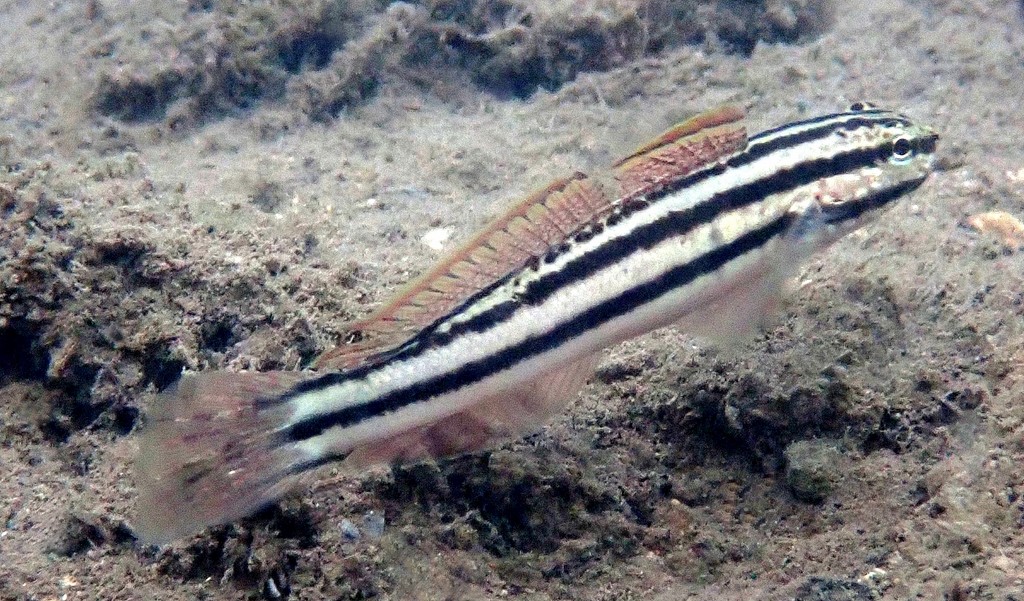AMBLYGOBIUS LINKI - (HERRE, 1927)
Picture courtesy of: Amaury Durbano
Actinopterygii (Gigaclass) > Actinopteri (Class) > Teleostei (Subclass) > Gobiiformes (Order) > Gobioidei (Suborder) > Gobiidae (Family) > Gobiinae (Subfamily) > Amblygobius (Genus)
Gobie de Link, Link's goby, Wakake-sarasahaze, ワカケサラサハゼ, 林克鈍鰕虎魚,
Description
Dorsal spines (total): 6-7; Dorsal soft rays (total): 13; Anal spine: 1; Anal soft rays: 12-13; Pectoral fin rays: 17; Pelvic fin rays: I, 5. First and second dorsal fin equal in height; Rounded caudal fin; Longitudinal scale series: 60; Lateral line scales: 19. Fully scaled predorsal region; Scales dorsally on opercle, absent on cheek; Ctenoid body scales; Cycloid scales on nape, abdomen, and opercle; Depth of body: 4.5-4.8 in SL. Max. length: 6.5 cm TL. Depth range: 1 - 10 m.
Color
Whitish body color with three black stripes on upper two-thirds of head and body; Presence of diffuse narrow bars on side.
Etymology
Amblygobius: from Greek, amblys or amblus = dull (blade: not sharp), blunt, obtuse + from Latin, gobius = gudgeon. Referring to compressed, convex and blunt head of Amblygobius sphynx.
linki: in honor of Capt. Francis Link, longtime resident of Jolo, Philippines, for his “indefatigable labors in advancing our knowledge of the Sulu Archipelago, and its fauna, flora, and people”.
Original description: Amblygobius linki Herre, 1927 - Type locality: Wharf at Bungau, Sulu Province, Philippines.
Distribution
Western Pacific: Amami-oshima and Yaku-shima Islands, Kagoshima, southern Japan, Vietnam, Indonesia, Philippines and New Caledonia.
Biology
Occurs on silty mud flats among the aerial roots of mangroves. Also found in stream mouths or occasionally in saline lakes.
Last update: 15, May 2024
Actinopterygii (Gigaclass) > Actinopteri (Class) > Teleostei (Subclass) > Gobiiformes (Order) > Gobioidei (Suborder) > Gobiidae (Family) > Gobiinae (Subfamily) > Amblygobius (Genus)
Gobie de Link, Link's goby, Wakake-sarasahaze, ワカケサラサハゼ, 林克鈍鰕虎魚,
Description
Dorsal spines (total): 6-7; Dorsal soft rays (total): 13; Anal spine: 1; Anal soft rays: 12-13; Pectoral fin rays: 17; Pelvic fin rays: I, 5. First and second dorsal fin equal in height; Rounded caudal fin; Longitudinal scale series: 60; Lateral line scales: 19. Fully scaled predorsal region; Scales dorsally on opercle, absent on cheek; Ctenoid body scales; Cycloid scales on nape, abdomen, and opercle; Depth of body: 4.5-4.8 in SL. Max. length: 6.5 cm TL. Depth range: 1 - 10 m.
Color
Whitish body color with three black stripes on upper two-thirds of head and body; Presence of diffuse narrow bars on side.
Etymology
Amblygobius: from Greek, amblys or amblus = dull (blade: not sharp), blunt, obtuse + from Latin, gobius = gudgeon. Referring to compressed, convex and blunt head of Amblygobius sphynx.
linki: in honor of Capt. Francis Link, longtime resident of Jolo, Philippines, for his “indefatigable labors in advancing our knowledge of the Sulu Archipelago, and its fauna, flora, and people”.
Original description: Amblygobius linki Herre, 1927 - Type locality: Wharf at Bungau, Sulu Province, Philippines.
Distribution
Western Pacific: Amami-oshima and Yaku-shima Islands, Kagoshima, southern Japan, Vietnam, Indonesia, Philippines and New Caledonia.
Biology
Occurs on silty mud flats among the aerial roots of mangroves. Also found in stream mouths or occasionally in saline lakes.
Last update: 15, May 2024
